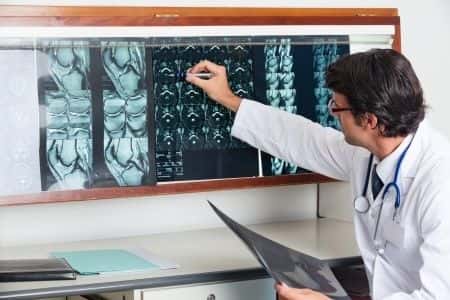Radiology Technician’s Positioning of Patient Leads to Paralysis
Updated on
This case involves a sixty-three-year-old patient that had a CT performed after an episode of syncope. The hospital staff admitted the patient overnight for observation purposes, as they were unable to rule out the possibility of a pulmonary embolism. The CT scan on the PACS digital system of the hospital showed severe spinal stenosis, which warranted a further imaging workup. The nuclear medicine technician performed a CT angiogram and a CT of the head the following day, but soon after, the patient sustained significant complications. During the procedure, the patient claimed that he was pulled and told to lift his hands over his head in an unnatural position for an extended period of time. According to the medical notes, the patient came out of CT in a paralyzed state and was subsequently considered to be a non-complete quadriplegic.
Question(s) For Expert Witness
1. Are you familiar with the GE device listed above and are the injuries sustained by the patient within the standard of care?
Expert Witness Response E-006277
 I am very familiar with both the GE VCT 64-slice CT scanner and the PACS imaging system as I use them in my home hospital on a daily basis. Generally speaking, the radiology tech should know about a patient's preexisting illness such as the severe stenosis shown on images in the hospital's internal EHR system. Once knowing the prior medical status of such a fragile patient, it is the duty of the technician to not place the patient in any compromising positions for extended periods of time. I believe this tech was egregious in the care given and paralysis could have been prevented without a doubt.
I am very familiar with both the GE VCT 64-slice CT scanner and the PACS imaging system as I use them in my home hospital on a daily basis. Generally speaking, the radiology tech should know about a patient's preexisting illness such as the severe stenosis shown on images in the hospital's internal EHR system. Once knowing the prior medical status of such a fragile patient, it is the duty of the technician to not place the patient in any compromising positions for extended periods of time. I believe this tech was egregious in the care given and paralysis could have been prevented without a doubt.
About the author
Michael Talve, CEO
Michael Talve stands at the forefront of legal innovation as the CEO and Managing Director of Expert Institute. Under his leadership, the Expert Institute has established itself as a vital player in the legal technology arena, revolutionizing how lawyers connect with world-class experts and access advanced legal technology. Michael's role involves not only steering the company's strategic direction but also ensuring the delivery of unparalleled intelligence and cutting-edge solutions to legal professionals. His work at Expert Institute has been instrumental in enhancing the capabilities of attorneys in case preparation and execution, making a significant impact on the legal industry's approach to expert consultation and technological integration. Michael's vision and execution have positioned the Expert Institute as a key facilitator in the intersection of law and technology.
Subscribe to our newsletter
Join our newsletter to stay up to date on legal news, insights and product updates from Expert Institute.
Sign up nowFind an expert witness near you
What State is your case in?
Subscribe to our newsletter
Join our newsletter to stay up to date on legal news, insights and product updates from Expert Institute.



